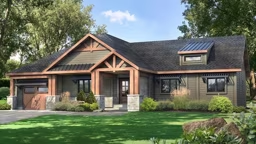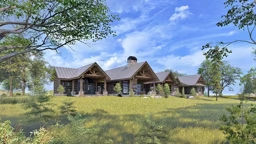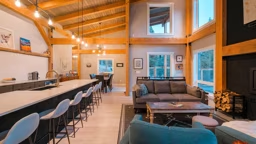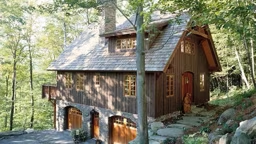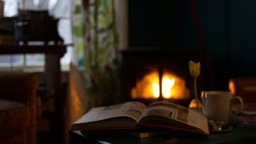

The Original Bitterroot Front Elevation
When people build a timber frame home, they are choosing to live in a unique house. Many of them take this personalization several steps further by creating a design that’s distinctive and fits their family size, their site topography or their individual needs exactly.
But even customized plans have to start somewhere. Erwin Loveland of MossCreek, a design firm based in Knoxville, Tennessee, says people often begin by choosing a stock plan that comes close to their vision and then making modifications that will give it a personal touch.
Let’s take a look at the simpleways a plan can be modified, and the inspiration that started it all.
The Original Bitterroot
Square Footage 2,379

It’s easy to understand the Bitterroot’s appeal. Its “just right” size is only one benefit of this plan. “It’s below that magic number of 2,500 square feet,” Erwin says, referring to the target that many homeowners seek.
Erwin explains another key aspect of the plan’s flexibility: “The corner pantry in the kitchen is easy to replace with a side entrance that can lead to an attached or detached garage. When people make this change, they usually remove the exterior door in the mudroom.”
Having a door somewhere in that vicinity is key, Erwin asserts. “Oftentimes, our homes are built along lakes or in the mountains, and people like a separate mudroom with a pocket door to the laundry,” he says. “If you come in through that entry, you can get out of messy or wet clothes and drop them there, so you won’t track sand and debris throughout the house.”
How it Can Work for You
Many of MossCreek’s plans start as second homes/vacation retreats, so they’re typically designed on the smaller side. This plan is perfect for that purpose, but with some minor changes, it also can work well as a full-time residence for empty-nesters who are looking to downsize.
Bitterroot Version 2
Square Footage 3,954
_12546_2023-05-31_11-49.gif)
To fit the Bitterroot plan to a sloped lot, one family made several changes. For starters, a third level was added. Then, that lower level was configured to include a two-car garage and a single bedroom suite, plus a den. On the main level, the family flipped the plan to place the kitchen on the left and the master suite on the right. Reversing a plan like this is easy, Erwin says, and it’s a common change that can help a house take better advantage of its site’s topography or views.
Upstairs, the Jack-and-Jill bath of the original plan is replaced by two separate private baths with showers. Back on the main floor, the master suite’s tub was swapped for an oversized shower— a request that’s becoming increasingly popular as people incorporate aging-in-place features into their homes, Erwin says. However, he still recommends keeping a bathtub somewhere in the house. If families with young children will ever stay there, a tub is a must.
How it Can Work for You
The privacy afforded by three levels and a separate bath for each of the two upstairs bedrooms — not to mention the second master suite in the basement — is an ideal arrangement to help keep the peace in families with teenagers. Plus, the drive-under garage is a much-appreciated addition in colder climates.
Bitterroot Version 3
Square Footage 3,954

The Jack-and-Jill bath shared by the upper-level bedrooms is both space efficient and cost effective. In the loft, a built-in desk along the wall on the right transforms that space into a cozy home office that overlooks the great room, but is still removed from the daily hubbub.
How it Can Work for You
Since this three-level variation boasts six bedrooms and four-and-half baths, it’s a popular choice as a rental home or a family retreat shared by several generations. Add a kitchenette to the basement and it can be fully autonomous.
Bitterroot Version 4
Square Footage 3,292

A couple with an adult child with a disability requested several unique changes to the base Bitterroot. “They wanted their child to have a level of independence but have the area be easily accessible,” Erwin explains. A second master suite on the first floor was the solution. It’s close to a very large laundry room but has its own entrance near the side entrance to the house.
The owners also added a porch off the main master and converted the porch off the dining area into a sunroom. A craft/hobby room was included near the front door.
Since the Bitterroot was originally planned as a vacation home, closets and bedrooms were on the smaller side. These homeowners added more closet space in the upstairs bedrooms to better accommodate their full-time residence needs.
How it Can Work for You
Having dual master suites on the main level has a host of advantages; particularly if you find you need to care for an aging parent to prevent them from entering an assisted-living facility. It’s also ideal for extended stay friends and family, affording them easy access to the kitchen as well as their own entry via the mudroom.Pro Tip: From Base Plan to Custom Home
Designers, architects and timber home producers expect home buyers to revise plans. When MossCreek works with clients, for example, the staff sends the clients paper floor plans and “elevation” views of all four sides of the home from the exterior. “They redline those with changes and send them back to us,” Erwin says. How the clients’ alterations affect the next step depends on how complicated they are.
He also cautions that it’s much easier to make a plan larger than smaller. “When you start making rooms smaller, they lose functionality,” he says. Spaces like bathrooms, kitchens and staircases have minimum required dimensions to meet safety codes or simply function properly.
If you want to alter roof lines, shrink a home down or move entire rooms around on a stock plan, choosing a different plan to revise or going with a completely custom design might be a more practical and less costly option.
Bonus Tip!
According to Allen Halcomb, the president of MossCreek, the best way to get what you want in the style of your house is to come prepared with pictures and ideas to share with your architect or designer. “Photographs are key when we’re talking about the style of a house,” explains Allen. “Even if we don’t wind up using the exact ideas, this will give your team of professionals an idea of what you want your home to look like.”
To convey your vision to those who you’re working with, it’s really quite simple: Keep some kind of log, whether it be hard copies or digital, with things that you like. Some people compile a notebook of clippings, while others bookmark photos for a digital file or pin them on websites. Simply look for homes and features that speak to you and keep them close by when it’s time for the design phase.
See also: 12 Tips to the Perfect Floor Plan




